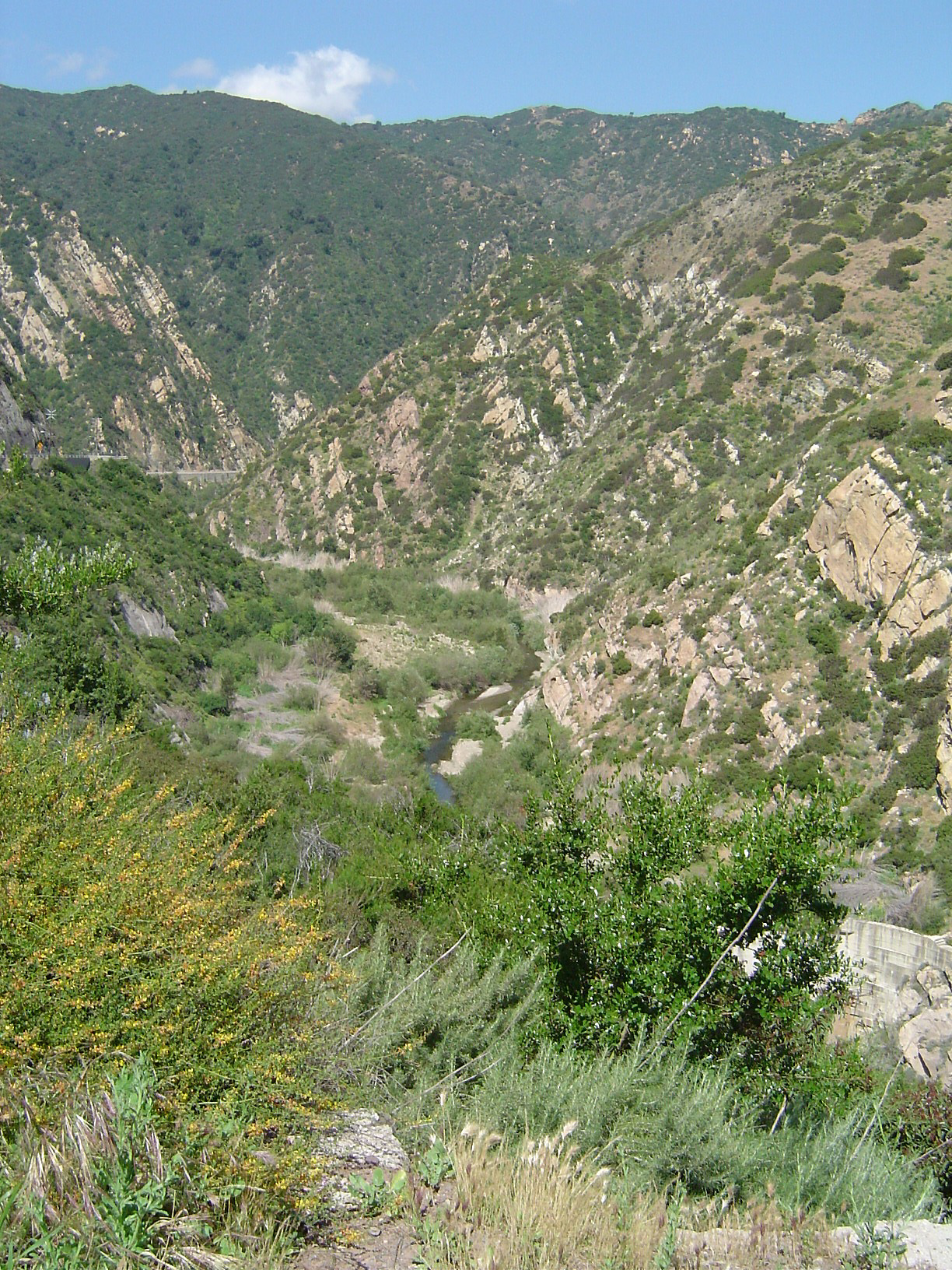|
Dendromecon
''Dendromecon'', the tree poppy, is a genus of one or two species of shrubs to small trees, native to California and northern Baja California. The leaves are evergreen, alternate, lanceolate to ovate, 3–10 cm long. The flowers are yellow, satiny, and shed after pollination. Species Two species of ''Dendromecon'' are widely accepted, though some botanists consider them to belong to just one species, only distinct at the lower rank of subspecies In biological classification, subspecies is a rank below species, used for populations that live in different areas and vary in size, shape, or other physical characteristics (morphology), but that can successfully interbreed. Not all species ...: References Flora of North America: ''Dendromecon'' [...More Info...] [...Related Items...] OR: [Wikipedia] [Google] [Baidu] |
Dendromecon Rigida
''Dendromecon rigida'', also called bush poppy or tree poppy, is a shrub or small tree of the Papaveraceae native to California and Baja California. Distribution and habitat ''Dendromecon rigida'' occurs in Northern California in the foothills of the California Coast Ranges, Klamath Mountains, southwest Cascade Range, and western Sierra Nevada in the Montane and Interior chaparral and woodlands and other habitats. It is found in the foothills of the Transverse Ranges and Peninsular Ranges and in other areas, in Interior and Montane chaparral and woodlands and other habitats, in Southern California and northern Baja California Peninsula. The plants occur in these regions up to in elevation. Plants grow on dry slopes and washes, and prefer areas that have just been burned. Description ''Dendromecon rigida'' is a small perennial shrub, rarely exceeding tall. The leaves are alternate, narrow lanceolate, 3–10 cm long, more than three times as long as broad. The marg ... [...More Info...] [...Related Items...] OR: [Wikipedia] [Google] [Baidu] |
Dendromecon Harfordii
''Dendromecon harfordii'', known by the common names Channel Islands tree poppy and Harford's tree poppy, is a species of flowering plant in the poppy family. It was formerly treated as subspecies of the related species ''Dendromecon rigida'', and had the botanical name ''Dendromecon rigida'' subsp. ''harfordii''. Distribution The plant is endemic to San Clemente Island, Santa Catalina Island, Santa Cruz Island, and Santa Rosa Island in the Channel Islands of California. It is found in California coastal sage and chaparral habitats on the islands. Description ''Dendromecon harfordii'' is a shrub or small tree reaching heights between . It has thin branching stems covered sparsely in smooth-edged, oval-shaped leaves 3 to 8 centimeters long. It bears showy flowers with four bright yellow petals each 2 or 3 centimeters long. The fruit is a curved, cylindrical capsule over 7 centimeters in length. Cultivation ''Dendromecon harfordii'' is cultivated as an ornamental plant, ... [...More Info...] [...Related Items...] OR: [Wikipedia] [Google] [Baidu] |
Papaveraceae Genera
The Papaveraceae are an economically important family of about 42 genera and approximately 775 known species of flowering plants in the order Ranunculales, informally known as the poppy family. The family is cosmopolitan, occurring in temperate and subtropical climates (mostly in the northern hemisphere), but almost unknown in the tropics. Most are herbaceous plants, but a few are shrubs and small trees. The family currently includes two groups that have been considered to be separate families: Fumariaceae and Pteridophyllaceae. Description The plants may be annual, biennial, or perennial. Usually herbaceous, a few species form shrubs or evergreen trees. They are lactiferous, producing latex, which may be milky or watery, coloured or plain. All parts contain a well-developed duct system (these ducts are called "laticifers"), producing a milky latex, a watery white, yellow or red juice. The simple leaves are alternate or sometimes whorled. They have petioles and are no ... [...More Info...] [...Related Items...] OR: [Wikipedia] [Google] [Baidu] |
Shrub
A shrub (often also called a bush) is a small-to-medium-sized perennial woody plant. Unlike herbaceous plants, shrubs have persistent woody stems above the ground. Shrubs can be either deciduous or evergreen. They are distinguished from trees by their multiple stems and shorter height, less than tall. Small shrubs, less than 2 m (6.6 ft) tall are sometimes termed as subshrubs. Many botanical groups have species that are shrubs, and others that are trees and herbaceous plants instead. Some definitions state that a shrub is less than and a tree is over 6 m. Others use as the cut-off point for classification. Many species of tree may not reach this mature height because of hostile less than ideal growing conditions, and resemble a shrub-sized plant. However, such species have the potential to grow taller under the ideal growing conditions for that plant. In terms of longevity, most shrubs fit in a class between perennials and trees; some may only last about fiv ... [...More Info...] [...Related Items...] OR: [Wikipedia] [Google] [Baidu] |
Papaveroideae
Papaveroideae is a subfamily of the family Papaveraceae (the poppy family). Genera * Subfamily Papaveroideae Eaton :* Tribe Eschscholzieae Baill. ::* '' Dendromecon'' Benth. – California. ::* '' Eschscholzia'' Cham. – Western North America. ::* '' Hunnemannia'' Sweet – Eastern Mexico. :* Tribe Chelidonieae Dumort. ::* '' Bocconia'' L. – Central and southern America, Antilles ::* ''Chelidonium'' L. – Eurasia ::* '' Dicranostigma'' Hook.f. & Thomson – Central Asia ::* '' Eomecon'' Hance – Eastern China ::* '' Glaucium'' Mill. – Europe to Central Asia ::* '' Hylomecon'' Maxim. – Eastern Asia ::* '' Macleaya'' R.Br. – Eastern Asia ::* '' Sanguinaria'' L. – Eastern North America ::* '' Stylophorum'' Nutt. – Eastern North America, Eastern Asia :* Tribe Platystemoneae Spach ::* '' Hesperomecon'' Greene – Western North America ::* '' Meconella'' Nutt. – Western North America ::* '' Platystemon'' Benth. – Western North America :* Tribe Papavereae Dum ... [...More Info...] [...Related Items...] OR: [Wikipedia] [Google] [Baidu] |
Sierra Nevada (U
The Sierra Nevada () is a mountain range in the Western United States, between the Central Valley of California and the Great Basin. The vast majority of the range lies in the state of California, although the Carson Range spur lies primarily in Nevada. The Sierra Nevada is part of the American Cordillera, an almost continuous chain of mountain ranges that forms the western "backbone" of the Americas. The Sierra runs north-south and its width ranges from to across east–west. Notable features include General Sherman, the largest tree in the world by volume; Lake Tahoe, the largest alpine lake in North America; Mount Whitney at , the highest point in the contiguous United States; and Yosemite Valley sculpted by glaciers from one-hundred-million-year-old granite, containing high waterfalls. The Sierra is home to three national parks, twenty wilderness areas, and two national monuments. These areas include Yosemite, Sequoia, and Kings Canyon National Parks; and ... [...More Info...] [...Related Items...] OR: [Wikipedia] [Google] [Baidu] |
Pacific Coast Ranges
The Pacific Coast Ranges (officially gazetted as the Pacific Mountain System in the United States) are the series of mountain ranges that stretch along the West Coast of North America from Alaska south to Northern and Central Mexico. Although they are commonly thought to be the westernmost mountain range of the continental United States and Canada, the geologically distinct Insular Mountains of Vancouver Island lie further west. The Pacific Coast Ranges are part of the North American Cordillera (sometimes known as the Western Cordillera, or in Canada, as the Pacific Cordillera and/or the Canadian Cordillera), which includes the Rocky Mountains, the Columbia Mountains, the Interior Mountains, the Interior Plateau, the Sierra Nevada, the Great Basin mountain ranges, and other ranges and various plateaus and basins. The Pacific Coast Ranges designation, however, only applies to the Western System of the Western Cordillera,S. Holland, ''Landforms of British Columbia'', BC Govt. 197 ... [...More Info...] [...Related Items...] OR: [Wikipedia] [Google] [Baidu] |
Channel Islands Of California
The Channel Islands () are an eight-island archipelago located within the Southern California Bight in the Pacific Ocean, off the coast of California. The four Northern Channel Islands are part of the Transverse Ranges geologic province, and the four Southern Channel Islands are part of the Peninsular Ranges province. Five of the islands are within the Channel Islands National Park, and the waters surrounding these islands make up Channel Islands National Marine Sanctuary. The Nature Conservancy was instrumental in establishing the Channel Islands National Marine Sanctuary. The islands were inhabited as early as 13,000 years ago, the earliest paleontological evidence of humans in North America. They are the easternmost islands in the Pacific Island group. The Chumash and Tongva Native Americans who lived later on the islands may be the descendants of the original inhabitants, but they were then displaced by Spaniards who used the islands for fishing and agriculture. T ... [...More Info...] [...Related Items...] OR: [Wikipedia] [Google] [Baidu] |
Endemic (ecology)
Endemism is the state of a species being found in a single defined geographic location, such as an island, state, nation, country or other defined zone; organisms that are indigenous to a place are not endemic to it if they are also found elsewhere. For example, the Cape sugarbird is found exclusively in southwestern South Africa and is therefore said to be ''endemic'' to that particular part of the world. An endemic species can be also be referred to as an ''endemism'' or in scientific literature as an ''endemite''. For example ''Cytisus aeolicus'' is an endemite of the Italian flora. ''Adzharia renschi'' was once believed to be an endemite of the Caucasus, but it was later discovered to be a non-indigenous species from South America belonging to a different genus. The extreme opposite of an endemic species is one with a cosmopolitan distribution, having a global or widespread range. A rare alternative term for a species that is endemic is "precinctive", which applies to s ... [...More Info...] [...Related Items...] OR: [Wikipedia] [Google] [Baidu] |
Synonym (taxonomy)
The Botanical and Zoological Codes of nomenclature treat the concept of synonymy differently. * In botanical nomenclature, a synonym is a scientific name that applies to a taxon that (now) goes by a different scientific name. For example, Linnaeus was the first to give a scientific name (under the currently used system of scientific nomenclature) to the Norway spruce, which he called ''Pinus abies''. This name is no longer in use, so it is now a synonym of the current scientific name, '' Picea abies''. * In zoology, moving a species from one genus to another results in a different binomen, but the name is considered an alternative combination rather than a synonym. The concept of synonymy in zoology is reserved for two names at the same rank that refers to a taxon at that rank - for example, the name ''Papilio prorsa'' Linnaeus, 1758 is a junior synonym of ''Papilio levana'' Linnaeus, 1758, being names for different seasonal forms of the species now referred to as ''Araschnia l ... [...More Info...] [...Related Items...] OR: [Wikipedia] [Google] [Baidu] |
Mary Vaux Walcott
Mary Morris Vaux Walcott (July 31, 1860 – August 22, 1940) was an American artist and naturalist known for her watercolor paintings of wildflowers. She has been called the "Audubon of Botany." Life Vaux was born in Philadelphia, Pennsylvania, to a wealthy Quaker family. After graduating from the Friends Select School in Philadelphia in 1879, she took an interest in watercolor painting. When she was not working on the family farm, she began painting illustrations of wildflowers that she saw on family trips to the Rocky Mountains in Canada. During these summer trips, she and her brothers studied mineralogy and recorded the flow of glaciers in drawings and photographs. The trips to the Canadian Rockies sparked her interest in geology. In 1880, her mother died and at 19 years old Vaux took on the responsibility of caring for her father and two younger brothers. After 1887, she and her brothers went back to western Canada almost every summer. During this time she became an ac ... [...More Info...] [...Related Items...] OR: [Wikipedia] [Google] [Baidu] |





.jpg)
